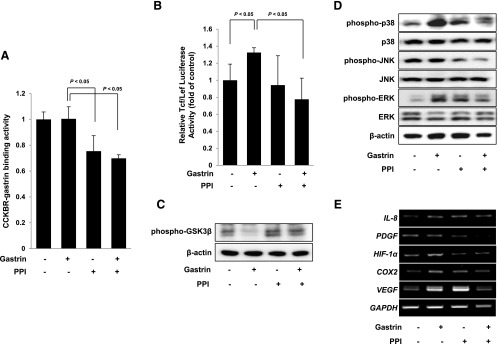Figure 5.

PPI suppresses gastrin-induced trophic effect through blockade of the binding of gastrin to its receptor. (A) To identify binding activity between CCKBR and gastrin, a sandwich ELISA was performed. PPI alone and the combination of PPI and gastrin significantly inhibited the binding between CCKBR and gastrin. (B) HCT116 cells were transiently transfected with the pTcf/Lef-Luc reporter vector. After transfection, the cells were cultured in serum-free medium with gastrin, PPI, or the combination of PPI and gastrin for 12 hours and the cell lysates were obtained to observe the luciferase activity. The combination of PPI and gastrin significantly decreased the luciferase reporter activity of Tcf/Lef. (C) Gastrin significantly inactivated GSK3β phosphorylation, but this inactivation was highly recovered with PPI treatment. (D) HCT116 cells were treated with gastrin, PPI, or the combination of PPI and gastrin for 12 hours and the phosphorylation of MAPKs was investigated. Gastrin induced the phosphorylation of p38 and ERK and the treatment with PPI downregulated their phosphorylations. (E) The changes in angiogenic factors including IL-8, PDGF, HIF-1α, COX-2, and VEGF were evaluated by reverse transcription-PCR. Gastrin induced the expression of angiogenic factors; however, PPI and the combination of PPI and gastrin inhibited the expression of angiogenic factors induced by gastrin.
